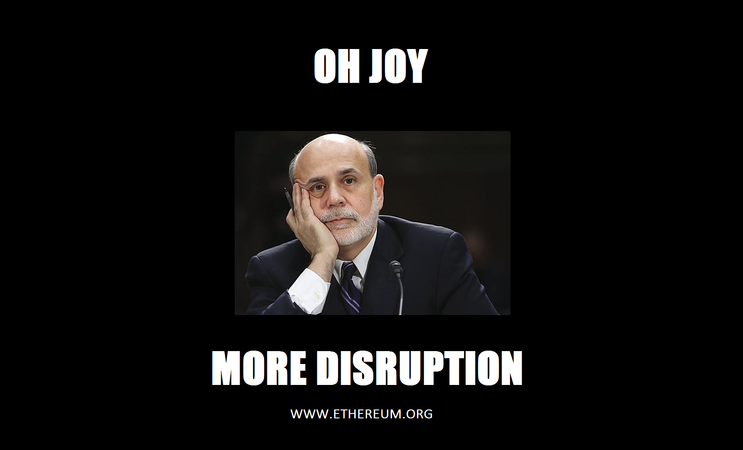Credit: Lightcoin on Ethereum.org.
Editor’s note: In the last eight years, Ethereum has grown in ways that many in 2014 could never have anticipated. We’re resurfacing this Q&A with Vitalik Buterin because we believe it frames an original snapshop of what Ethereum could be — a glimpse of a very specific moment in time. By understanding the early thoughts, insights, and hopes around Ethereum, directly from its co-founder, we hope to provide unique insight into where the concept began, thus giving more context to the transformations in the cryptocurrency landscape that Ethereum has catalyzed.
Just before last New Year’s, 19-year-old Vitalik Buterin, a Canadian college dropout and Bitcoin enthusiast, had an idea. By the end of last week, that idea had attracted more than $5 million in the first week of its pre-sale — a new kind of crowdfunding that crypto-currency makes possible. Not bad, especially considering that nobody knows whether the idea will really work.
Buterin’s idea was Ethereum, a platform designed to be what Bitcoin is to money for just about everything else. Bitcoin works by spreading the currency’s entire history of transactions — the blockchain, it’s called — out across the whole network of its users. Rather than just recording transactions, Ethereum’s blockchain would be able record and execute any program you can code. Bitcoin is a pretty interesting fish, but Ethereum is poised to be the whole ocean. Voting systems, file storage, financial instruments, all sorts of contracts — these things and more could become cheaper, faster, and more widely accessible over a distributed network.
In theory, it could transform the architecture of the Internet and the infrastructure of the economy. In practice, who knows.
As the pre-sale entered its second week, I spoke with Buterin — now 20 — about Ethereum’s progress and the possibilities he imagines. The platform is poised to open up an ethereal commons, one that could change how we interact and transact online. What remains to be seen is what people will choose to do there, and how various interests might seek to enclose it.

Nathan Schneider: What exactly is a pre-sale, to begin with? Why are people spending millions of dollars to buy ether, Ethereum’s built-in currency?
Vitalik Buterin: It is a new business model that has become quite popular over the last year; Mastercoin, in August, was the first with $500,000 sold, followed by many others, including pre-sales by MaidSafe and Swarm, and then our own. The idea is that you create a new protocol with a currency built in, where the currency has some special value inside of that protocol. Then you sell the first few units of the currency to fund development. In Ethereum, ether is used to pay transaction fees.
Do you think this is a promising model for raising funds for other kinds of non-profit projects?
For certain classes of projects, yes. I think we may be in a bit of a bubble phase right now, where people are thinking that everything can be made into a protocol with a currency and then pre-sold. Earlier this year, people saw Mastercoin’s market cap going up to more than $60 million, so everyone jumped on seeing how easily they can earn millions on a sale. But now it’s cooling off somewhat. For some projects, there is not enough network effect, so it makes more sense to just use some other currency — whether it’s bitcoin, ether, or dollars — than to make your own. There are also other interesting possibilities for monetization that are underexplored, such as selling a namespace.
Right — to make a currency valuable to people, you need to give them some reason to believe they could use it. Was there any discussion that maybe the pre-sale would also involve ownership or decision-making membership in Ethereum?
That buying ether would give people decision-making rights over the project?
How has the pre-sale compared with your expectations?
I actually wasn’t sure what to expect. There was a huge amount of interest, but sometimes it’s hard to say whether or not interest will translate into people actually putting in money. Right now we’ve reached the low end of what we thought we would raise during the entire sale, but it’s likely that we’ll see a substantial spike a bit later into the sale; the reason is that, if you buy just before the initial two weeks ends, you get the low price, but you also get the benefit of knowing how many people bought before you.
What are some of the first things you expect people to be coming to Ethereum to do, things they can’t do on the Internet as it is?
There are lots of apps that become absolutely trivial to write. I’ve replicated Kickstarter in 40 lines of code. There are a bunch of possibilities in the financial space: prediction markets, lotteries, or financial derivatives to hedge against cryptocurrency volatility. There’s also a lot that can be done with cloud computing, such as proper decentralized file storage. Ultimately, imagine an entire online forum that does not have any server anywhere, and automatically accepts advertising to fund itself and pays to host its data on whatever machines become available. It’s like the Lego of crypto-finance and communication.
Many people feel that the initial promise of the Internet is being lost due to the likely erosion of net neutrality and the growing power of a small number of big companies. Can Ethereum help reverse this tendency?
Let’s talk about net neutrality and Internet service providers — that example is fun. Right now, all Internet traffic flows through a few ISPs. They overcharge, they don’t really innovate, and they give preferential treatment to big business. For about 10 years, there has been the alternative idea of mesh networking, where we get rid of ISPs and, instead, have Internet messages relayed directly — person-to-person, laptop-to-phone-to-laptop. Theoretically, this completely solves the problems caused by ISPs. So, why hasn’t it succeeded?
The reason is that inside of one city, it works fine; but when you need to send a message, say, from Toronto to Sydney, that’s 15,000 kilometers, or 45,000 cell phone and laptop hops, even with optimal hardware. Even that assumes there are nodes going all along the ocean. It’s obviously far too slow and expensive. We need large, undersea cables and professional infrastructure for international routing. So, here’s the new solution: incentivized mesh networking. Anyone can join the network as a node. Anyone can charge for being a relay node for other people’s messages. And if I want to send a request to some server, I run a graph-search algorithm to find the shortest, cheapest path. So, if you pay a few microcents per kilobyte, your messages get transferred. If you have a phone, you can participate in the network and get a few cents an hour. Large companies can also participate. I could start a company whose sole purpose is to run and maintain a single wire going from Vancouver to Melbourne and collect fees off that. If my wire is the fastest, cheapest way to get messages over, people will use it. If I filter traffic from Wikileaks, then Wikileaks users can just use someone else’s wire instead.
The result is maximum modularity, minimum barrier to entry, an optimal marketplace. This allows you to incorporate satellites, undersea cables, intercity cables, phones, and more all into one network. That’s how we fix the Internet’s issues of monopoly and net neutrality.
And this could be done on Ethereum?
Ethereum could be a part of the solution. Or you could use similar principles and do it independently. OpenGarden is trying on their own, and I think some group in Israel is trying this on Ethereum.

Photo credit: BCFrictionless on BitcoinTalk.org.
The word “optimal” always makes me wonder, “Optimal for whom?” For instance, have you seen interest in Ethereum expressed in poor countries or poor communities that might benefit from the lower barriers to entry?
We heard from one guy in the Philippines just a week ago, actually. Mesh networking is ideal for poor countries, because they often don’t even have ISPs. We also have seen quite a bit of interest in Argentina. So, no place Africa-level poor yet, but some. Just as for Bitcoin, it takes time to permeate.
What will it take for people to access and contribute to the Ethereum environment? What kind of software, and what kind of capital?
People will need a laptop and a minimal Internet connection — which amounts to a capital investment of less than $300.
And someone would need ether, as well, right?
Only a few units of ether to get started, really. Ether is needed for transaction fees, which is why cutting fees down is one of our primary concerns.
Is it true that you’ll be giving grants of ether to non-profits to develop projects on Ethereum? Who will decide how those are allocated?
Yes, and we’re still working on that process.
And what software will people need to participate?
The Ethereum client, plus a basic development environment — all free, open-source tools.
And Ethereum has its own browser, correct?
Yes. Well, it is still very early in development.
Why is that needed? In a world where Ethereum really takes off, would it replace conventional browsers?
I think there’s a need for a browser that is decentralization-friendly, in general — one that supports Ethereum, supports MaidSafe, supports decentralized file storage and decentralized naming schemes.
So embracing decentralization means changing how we interface with the online world?
It’s something that can be embraced to greater or smaller extents. But, ultimately, it may require some drastic re-engineering, which is probably a good thing. The Internet as designed in the 1990s was not intended to be particularly secure.
How will the Ethereum system be governed? Are you concerned about it becoming monopolized by private interests?
It is being governed by a non-profit entity at this point. One of the reasons why we did the ether sale is actually to avoid being monopolized by private interests. If you look at Bitcoin’s core developers, half are hired by big companies like BitPay and Coinbase, and half are employed by the Bitcoin Foundation, which itself gets most of its funding from private interests. This is concerning. Now we have some quantity of funds that will let us stay independent. Figuring out how to run decentralized protocols and continue developing them without risk of corruption is a fundamentally hard problem.
And is the goal still to run Ethereum through the Ethereum system itself — meaning that the community of participants would be able to govern the infrastructure they use?
Yes, that’s the ultimate goal.
What would that enable you to do that a conventional non-profit can’t?
Ideally, the community’s control would be maximally direct. With a conventional non-profit, it might start off reasonable and representative of the community, but inevitably some kind of specialized class emerges that sticks close to the center of the organization. Participation becomes a matter of who you know. Even formal democracies like governments don’t avoid this problem.
And Ethereum could — by making sure that decision-making is more transparent on the decentralized system?
Transparency is one way of doing it, but it’s probably not the full solution. The governance process also has to be highly accessible — and code is nice because it can be. Anyone can submit a patch to GitHub. But, then, that’s just a mechanism for making proposals, not deciding on them. Deciding is the hard part.
This has been such a sudden and wild process for you, I’m sure. What have been the toughest challenges of the past seven months, and what lessons have you learned?
Running a geographically distributed organization between five countries is hard. That’s likely the big one. And I’ll say that, having both founded Ethereum and co-founded Bitcoin Magazine, which works similarly, even if we have awesome cryptocurrencies and communication protocols, there’s still quite a bit of sociology that needs to catch up.









